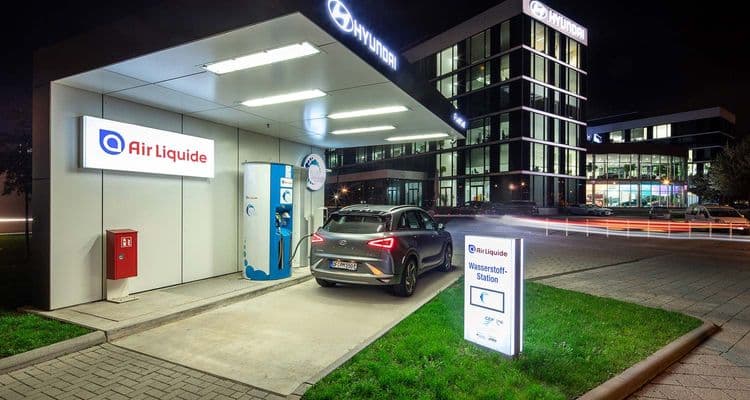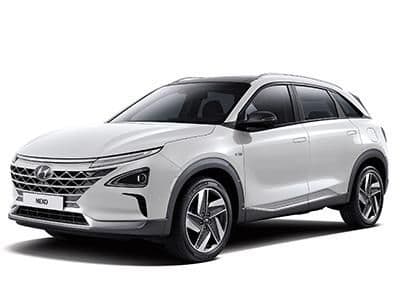
The drive of tomorrow, today
Fuel consumption (hydrogen) in kg/100km combined for the Hyundai Fuel Cell: 0.95; CO2 emissions: 0 g/km (combined). CO2 efficiency class: A+. The new Hyundai Nexo has not yet been homologated for the German market. The homologation and fuel consumption determination of the German country version will take place as part of the market launch. Vehicle illustration may differ and may contain optional extras at extra cost*.
Fuel consumption (hydrogen) in kg/100km combined for the Hyundai Fuel Cell: 0.95; CO2 emissions: 0 g/km (combined). CO2 efficiency class: A+. The new Hyundai Nexo has not yet been homologated for the German market. The homologation and fuel consumption determination of the German country version will take place as part of the market launch. Vehicle illustration may differ and may contain optional extras at extra cost*.
Our offers
No vehicles found.
Hyundai Nexo
In an H2 fuel cell, chemical reaction energy is generated by the continuous supply of fuel and oxidising agent and then converted into electrical energy and stored in transaction batteries. Additional energy is fed into the battery through recuperation, kinetic energy generated during braking, for example. This drives the electric motor in the vehicle. During the journey, the fuel cell recharges the battery, which enables a long range. The combination of fuel cell and electric motor generates a higher level of efficiency than a petrol or diesel combustion engine. The only disadvantage: the use of platinum, one of the most expensive metals in the world, explains the relatively high manufacturing and purchase costs of a vehicle with a fuel cell.
Thanks to state-of-the-art fuel cell technology, the Hyundai NEXO has a range of up to 756 kilometres*. The drive system, which emits zero emissions, is suitable for both short and long journeys. With a modern interior design and intelligent safety, it is a purchase that is well worth it.
Worth knowing
Hydrogen, but also methane or methanol can be used as fuel. The way in which the fuel is obtained is crucial for assessing its sustainability. In order to be able to produce vehicles with fuel cells with an output of over 100 kW, it is necessary to raise the operating temperature from 80°C to 100°C without further reducing efficiency.
The 700-800 bar pressure tank systems installed in the vehicles weigh around 125kg and are made of hydrocarbon fibre-reinforced plastic. Despite this additional weight, the increased storage density of the fuel results in a range of up to 756 kilometres*.
The technology developed by Christoph Friedrich Schönbein back in 1838 consists of two electrodes, the anode (negative pole) and the cathode (positive pole). These two poles are separated by a solid, ion-permeable membrane (electrolyte). The electrodes are coated with a catalyst (nickel, platinum) and connected by an external circuit. When hydrogen is fed into the anode, it is split into protons and electrons. Electrical energy is generated directly from the electrons. The protons reach the cathode, combine with the oxygen from the air and the electrodes, which are diverted via the external circuit, to form water and heat.
Half and annual cars
Everything under one roof
35 years of experience
Um diesen Inhalt anzeigen zu können, ist Ihre Zustimmung erforderlich.
* Die Maximale Reichweite des Hyundai Nexo beträgt bis zu 756 km bei idealen Verkehrsbedingungen, Fahrzeugausstattungen und optimaler Fahrweise. Im realen Fahrbetrieb kommt es zu einer geringeren Reichweite.
© 2025 CSB Schimmel Automobile GmbH. All rights reserved.

Die Setzung einiger Cookies ist zwingend erforderlich. Für bestimmte Dienste benötigen wir Ihre Einwilligung.
Durch den Klick auf „Alle Cookies akzeptieren“, willigen Sie (jederzeit für die Zukunft widerruflich) in alle Datenverarbeitungen (Setzung von Cookies und Übermittlung der IP-Adresse an Partner) ein.
Durch den Klick „ Alle optionalen Cookies ablehnen“ werden alle nicht zwingend notwendigen Cookies nicht gesetzt und Verbindungen unterbunden. Die Nutzung unserer Webseite ist dann stark eingeschränkt.
Durch den Klick auf „ Lassen Sie mich wählen“ können Einstellungen geändert und der Datenverarbeitung eingewilligt werden. Ihre Auswahl kann jederzeit angepasst werden.
Hinweis auf Verarbeitung der Daten in den USA (z.B. durch Google, Facebook, Youtube): Durch den Klick auf „Alle Cookies akzeptieren" oder bei der entsprechenden Auswahl eines Anbieters, willigen Sie zugleich darin ein, dass Ihre Daten in den USA verarbeitet werden. Die USA wird als ein Land mit einem nicht ausreichenden Datenschutzniveau angesehen. Es besteht u.a. das Risiko, dass Ihre Daten durch US-Behörden, zu Kontroll- und zu Überwachungszwecken, möglicherweise auch ohne Rechtsbehelfsmöglichkeiten, verarbeitet werden können. Bei dem Klick auf „Alle optionalen Cookies ablehnen“, findet keine Datenübermittlung statt.
Weitere Informationen finden Sie unter Datenschutz. Zum Impressum.













